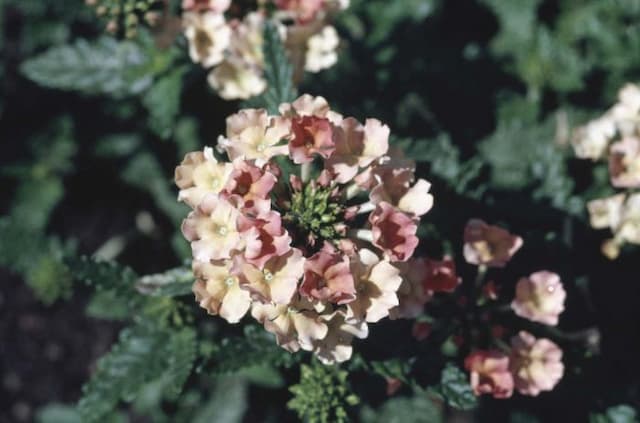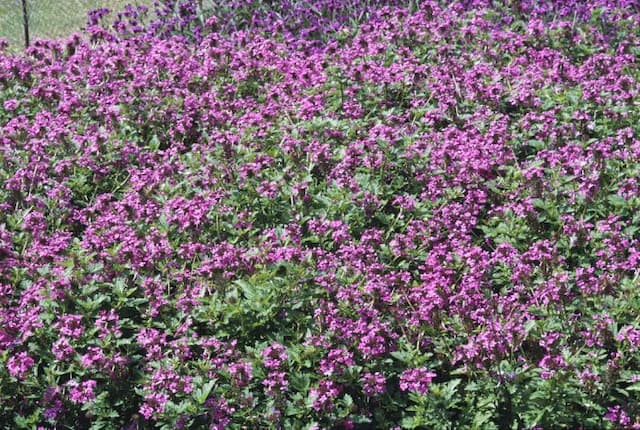Lantana Lantana camara

ABOUT
Lantana camara, commonly known as lantana, is a visually striking plant with a rugged, bushy appearance. It is well-loved for its clusters of petite, vibrantly colored flowers that come in shades of red, orange, yellow, blue, white, pink, and purple, often mixing these colors within the same cluster to create a kaleidoscope effect. The flowers are small and tubular, blooming generously in broad, flat-topped clusters called umbels. The leaves of lantana add to its textural interest; they are rough to the touch and generally oval-shaped, with edges that can be either serrated or scalloped. These leaves are noted for their strong, pungent aroma when crushed or brushed against, a scent that is often described as sharp or spicy. Lantana stems can become woody with age, and the plant has a robust and somewhat sprawling growth habit, which can give it a somewhat wild, untamed look. In color, the foliage typically presents a deep green, which serves as a lovely backdrop to the vivid coloring of the lantana flowers. In its blooming season, lantana becomes a hub of activity, drawing butterflies, bees, and birds, who are all attracted to the nectar-rich flowers. This activity adds an extra element of dynamism to its appearance. Despite its allure in the garden, it is worth noting that lantana can be considered invasive in some areas and the berries it produces are toxic if ingested.
About this plant
 Names
NamesFamily
Verbenaceae
Synonyms
Big-Sage, Wild-Sage, Red-Sage, White-Sage, Tickberry, West Indian Lantana, Lantana, Shrub Verbena
Common names
Lantana aculeata, Lantana armata, Lantana mista, Lantana nivea, Lantana scabra, Lantana suaveolens, Camara vulgaris.
 Toxicity
ToxicityTo humans
Lantana, commonly known as the lantana plant, is toxic to humans if ingested. The toxicity is primarily due to the presence of triterpenoids, which are compounds found in the plant's leaves and green, unripe berries. Ingesting any part of the plant can cause symptoms such as vomiting, diarrhea, abdominal pain, and weakness. In severe cases, lantana poisoning can lead to more serious conditions like liver damage, characterized by jaundice (yellowing of the skin and eyes), and may require medical attention.
To pets
Lantana is also toxic to pets, including dogs, cats, and herbivorous animals. The toxicity comes from the same triterpenoids that affect humans. Symptoms of lantana poisoning in pets can include vomiting, diarrhea, labored breathing, weakness, and in severe cases, liver failure, which may be evidenced by jaundice. If a pet ingests lantana, it is crucial to seek veterinary care promptly, as the ingestion of this plant can be potentially life-threatening.
 Characteristics
CharacteristicsLife cycle
Perennials
Foliage type
Evergreen
Color of leaves
Green
Flower color
Mixed
Height
6 feet (1.8 meters)
Spread
3 feet (0.9 meters)
Plant type
Shrub
Hardiness zones
9
Native area
Central and South America
Benefits
 General Benefits
General Benefits- Aesthetic Appeal: Lantana camara, commonly known as Lantana, offers a vibrant array of flower colors that enhance the visual beauty of gardens and landscapes.
- Drought Tolerance: Lantana is highly resilient to dry conditions, making it an ideal choice for water-wise gardening in arid and semi-arid regions.
- Pollinator Attraction: The flowers of Lantana serve as a nectar source for butterflies, bees, and other beneficial insects, promoting biodiversity.
- Low Maintenance: Lantana is generally easy to care for, requiring minimal attention once established, which is perfect for low-maintenance landscapes.
- Heat Resistance: It thrives in warm to hot climates, demonstrating a high tolerance for heat and sun exposure.
- Soil Adaptability: Lantana can grow in a variety of soil types, from sandy to loamy, as long as they are well-drained.
- Fast Growth: The plant grows quickly, providing rapid coverage for garden areas or empty spaces that need filling.
- Long Blooming Season: Lantana has a lengthy blooming period that extends throughout the summer and sometimes beyond, offering sustained color in the garden.
- Control Erosion: Its dense growth habit makes it effective in stabilizing soil and preventing erosion on slopes or in other vulnerable areas.
- Wildlife Habitat: Lantana provides shelter and breeding spots for various species of wildlife, contributing to a healthy ecosystem.
- Variety of Uses: Lantana is versatile, suitable for use in flower beds, borders, containers, and as ground cover or mass plantings.
- Deer Resistance: It is less palatable to deer than many other garden plants, reducing the likelihood of damage from grazing.
 Medical Properties
Medical Properties- Antimicrobial: Lantana camara has been traditionally used for its antimicrobial properties, which may help fight against bacteria and fungi.
- Anti-inflammatory: It contains compounds that may reduce inflammation, which can be beneficial in treating conditions like arthritis.
- Wound healing: It has been applied topically in some cultures to promote the healing of wounds and skin ulcers.
- Antipyretic: The plant has been used in traditional medicine to help reduce fever.
- Antiseptic: In some folk traditions, extracts of the plant are used for their antiseptic properties to clean wounds.
- Analgesic: There are claims of its use to alleviate pain, though scientific evidence supporting this is not robust.
 Air-purifying Qualities
Air-purifying QualitiesThis plant is not specifically known for air purifying qualities.
 Other Uses
Other Uses- Lantana camara can be used as a natural dye for fabrics, providing a range of colors from yellows to browns depending on the part of the plant used.
- The aromatic leaves of Lantana camara can be used as an insect repellent when crushed and applied to the skin or when the leaves are burned like incense.
- Lantana camara has been used in traditional basket weaving due to the flexible and sturdy nature of its stems.
- In some regions, Lantana camara is used as a natural fencing material due to its dense growth and the ability to form a living barrier.
- The plant is sometimes integrated into companion planting schemes as it can attract pollinators like butterflies and bees to gardens.
- Dried Lantana camara stems can be used as small fuel sticks for starting fires, both in cooking fires and for warmth.
- The flowers of Lantana camara can be used to make a natural, color-changing pH indicator solution in educational science experiments.
- Some cultures use Lantana camara wood for making small handcrafted items such as musical instruments due to its workability and finish.
- Lantana camara is used in some regions for soil stabilization and erosion control because its roots help to hold the soil in place.
- Lantana camara leaves can be added to compost piles as a green material that provides nitrogen to help break down organic matter.
Interesting Facts
 Feng Shui
Feng ShuiThe Lantana is not used in Feng Shui practice.
 Zodiac Sign Compitability
Zodiac Sign CompitabilityThe Lantana is not used in astrology practice.
 Plant Symbolism
Plant Symbolism- Rigidity: Lantana camara, often known simply as lantana, can symbolize an attitude of unyielding or inflexibility due to its woody and somewhat stiff form as it matures.
- Ever-changing: The flowers of the lantana plant change color as they age, representing change and transformation in life.
- Warning: Many parts of the lantana plant are toxic when ingested, which can symbolize caution or warding off negativity.
- Persistence: Lantana is known for its ability to thrive in harsh conditions, symbolizing perseverance and tenacity.
- Attraction: Lantana flowers attract butterflies, thus, can symbolize allure and attractiveness.
 Water
WaterLantana, also known as lantana camara, should be watered when the top inch of soil feels dry to the touch, usually about once a week. The plant is drought-tolerant and does not require excessive water. It's best to water deeply so that the water reaches the root zone, using approximately one gallon of water per plant for outdoor lantanas or half a cup for smaller indoor pots every watering session. During the hot summer months, you may need to water more frequently, while in cooler months, you can reduce the watering frequency. Always avoid overhead watering to prevent fungal diseases, and ensure the pot has good drainage.
 Light
LightLantana camara flourishes in full sun conditions, meaning it needs at least six hours of direct sunlight daily. The ideal spot for this plant is a location where it receives ample morning light and protection from the intensity of the afternoon sun, although it can tolerate full sun all day in cooler climates. Lantana will bloom less and may become leggy if it does not get enough light.
 Temperature
TemperatureLantana camara grows best in warm temperatures, ideally between 60 and 85 degrees Fahrenheit. They can tolerate temperatures down to about 28 Fahrenheit but will be damaged or may die if exposed to frost. In regions where temperatures drop below this point, lantana should be treated as an annual or brought indoors to overwinter.
 Pruning
PruningPruning lantana camara encourages bushier growth and more blooms. Prune back lantana in the early spring to remove dead or woody stems, and throughout the growing season, deadhead spent flowers to encourage new growth. The plant can be cut back by a third of its size if it becomes too leggy. The best time to prune lantana is after the last frost when new growth begins.
 Cleaning
CleaningAs needed
 Soil
SoilLantana, or lantana camara, thrives in a well-draining soil mix consisting of peat, perlite, and pine bark in equal parts. The ideal pH range for lantana is between 6.5 and 7.5, which is slightly acidic to neutral.
 Repotting
RepottingLantana should be repotted every 1 to 2 years, or when it has outgrown its current container to encourage healthy growth and prevent root-bound conditions.
 Humidity & Misting
Humidity & MistingLantana prefers a moderate level of humidity but is quite adaptable. The best humidity level for this plant is around 40-50%.
 Suitable locations
Suitable locationsIndoor
Provide bright light, well-draining soil, occasional pruning for Lantana indoors.
Outdoor
Place Lantana in full sun, enrich soil with compost, water regularly outdoors.
Hardiness zone
9-11 USDA
 Life cycle
Life cycleLantana camara, commonly known as lantana, begins its life cycle from seed, which germinates under warm conditions after a period of dormancy which can be broken by processes such as scarification. The seedling emerges and grows into a woody, perennial shrub with square, often prickly stems. Following a period of vegetative growth, lantana flowers develop at the stem tips in clusters called umbels, showcasing a range of colors often changing as they mature, which is a unique characteristic of lantana. After pollination, often by butterflies and other insects, the flowers produce small, fleshy drupes which contain seeds and may change color to blue or black as they mature. These fruits are eaten by birds and other animals, aiding in the dispersal of the seeds to new locations. Seasonally or annually, depending on the climate, the plant may become dormant, reducing growth and conserving energy, but in suitable tropical and subtropical conditions, it may remain evergreen and continue to grow and reproduce year-round.
 Propogation
PropogationPropogation time
Spring-Summer
The most popular method for propagating Lantana, also known as lantana, is through stem cuttings. Ideally, this should be done in the late spring to early summer when plant growth is most active. To propagate lantana from stem cuttings, one should select healthy, non-flowering stems and cut a 4 to 6-inch section just below a leaf node. The lower leaves should be removed, and the cut end may be dipped in rooting hormone to encourage root development. The cutting should then be placed in a well-draining soil mix, ensuring at least one or two nodes are buried where the leaves were removed. Adequate moisture must be maintained, and the cutting should be kept in a warm environment with indirect sunlight. Roots typically form within a few weeks, after which the new lantana plant can be transplanted to a more permanent location.








